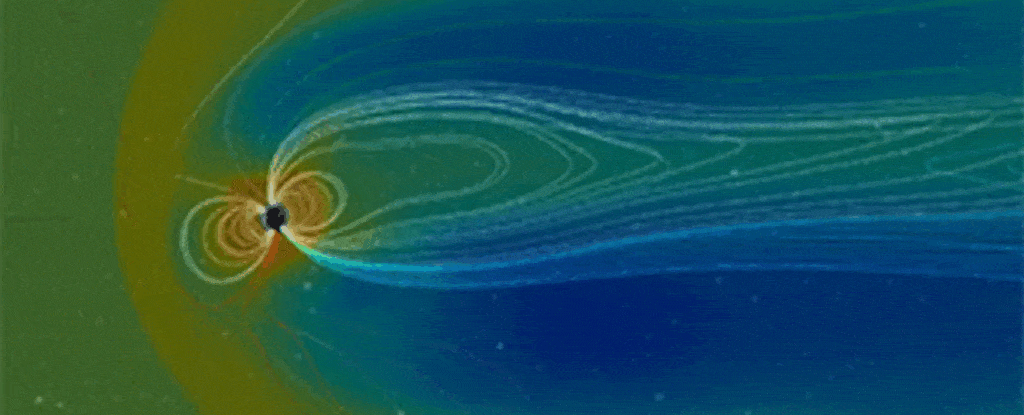Key takeaways:
- Earth’s magnetic field flipped around 41,000 years ago during the Laschamps event, with the north and south poles reversing positions, and the field weakening to only 5% of its current strength.
- This magnetic reversal allowed more cosmic rays to reach Earth, doubling beryllium-10 isotope levels and potentially impacting the ozone layer, which may have contributed to climate changes and even extinction events.
- The Swarm satellite mission by the European Space Agency (ESA) captures data on Earth’s magnetic field, allowing scientists to interpret the Laschamps event’s impact through natural sound representations.
- While anomalies like the South Atlantic anomaly have raised concerns of an impending magnetic flip, recent research indicates these irregularities may not predict such a reversal.
- The ESA’s Swarm mission, active since 2013, gathers critical data on Earth’s magnetic field, helping scientists better predict and understand future geomagnetic fluctuations and their effects on life and technology.
____________________
Earth’s magnetic field weakened to only 5% of its strength during the Laschamps event.

Around 41,000 years ago, Earth experienced a dramatic reversal of its magnetic field known as the Laschamps event, marking a significant period of environmental change and increased cosmic radiation. Scientists from the Technical University of Denmark and the German Research Center for Geosciences have now transformed data from this ancient event into an eerie audio representation. By interpreting shifts in Earth’s magnetic field lines collected by the European Space Agency’s (ESA) Swarm satellite mission, they recreated the unsettling “sound” of this upheaval, which mirrors creaking wood and crashing rocks.
Understanding Earth’s Magnetic Reversal
Earth’s magnetic field, created by swirling molten metals in the planet’s core, extends thousands of kilometers into space, protecting life on Earth from harmful solar particles. Normally, the magnetic field flows in closed loops, oriented south to north above Earth’s surface. However, every so often, the field flips, switching polarities and causing magnetic compasses to point south instead of north. The Laschamps event was the last major reversal, which lasted roughly 690 years, including a 250-year transition period. At its weakest, the field dropped to a mere 5% of its current strength, allowing higher levels of cosmic rays to reach Earth’s surface.
Evidence of this magnetic reversal was discovered in lava flows in Laschamps, France, and it left a traceable signature of increased cosmic ray bombardment. Ice cores and marine sediments record a marked increase in beryllium-10 isotopes—nearly double the usual level—during this event. These isotopes form when cosmic rays interact with Earth’s atmosphere, producing highly reactive particles that ionize the air and significantly weaken the ozone layer. Some scientists speculate that the Laschamps event may have impacted global climate and even contributed to events like the extinction of Australia’s megafauna and changes in human behavior, such as increased cave habitation for shelter from radiation.
Insights from ESA’s Swarm Satellite and Modern Magnetic Field Behavior
Since 2013, ESA’s Swarm satellite constellation has monitored magnetic signals originating from Earth’s core, mantle, crust, oceans, ionosphere, and magnetosphere. These signals help researchers track fluctuations in Earth’s geomagnetic field, offering a clearer understanding of its behavior. Notably, recent anomalies like the weakening of the magnetic field over the Atlantic Ocean—known as the South Atlantic Anomaly—have raised questions about a possible upcoming reversal. While these anomalies expose satellites to increased radiation levels, current research suggests they may not indicate an imminent flip.
Geophysicist Sanja Panovska of the German Research Center for Geosciences highlighted the importance of studying extreme events like the Laschamps reversal for predicting future space weather and assessing potential environmental impacts. Understanding such events can provide essential insights into Earth’s geological and atmospheric response to dramatic changes in the magnetic field. Today’s mapping of the Laschamps event offers a unique way to interpret magnetic data by converting it into sound, allowing us to “hear” the turbulent forces that shape our planet’s protective shield.
The ESA Swarm mission continues to gather invaluable data, helping scientists prepare for possible future fluctuations or reversals in Earth’s magnetic field, which remains a powerful yet delicate force with profound implications for life on Earth.





Well, I guess I’m not easily horrified by magnetic fields flipping! Just sounded like normal house noises to me.
It wasn’t a horror. What if they used music notes instead of creaking wood? That would be interesting.
The sound is quite comical, but when you think about the amount of different things that have to happen to keep the earth as a viable location for “life” as we know it, it’s frightening how close to total death and destruction we are.
Sounds like my joints when im getting out of bed in the morning
Sounds like an intro to some prog-rock I listen to.
Im pretty sure thats just a door opening
I think I heard that in Twin Peaks:The Return.